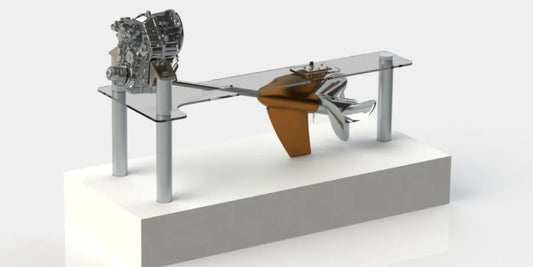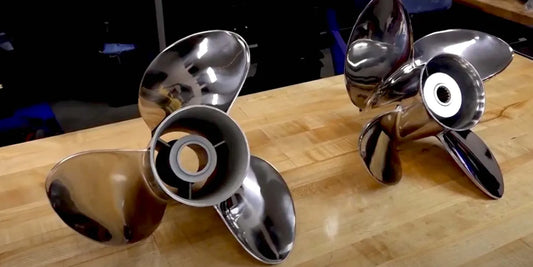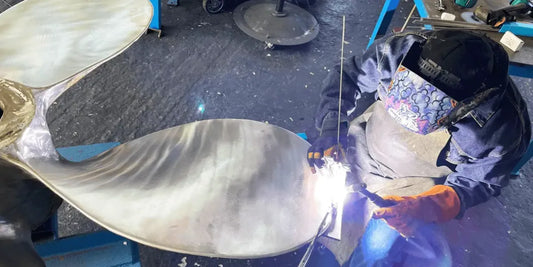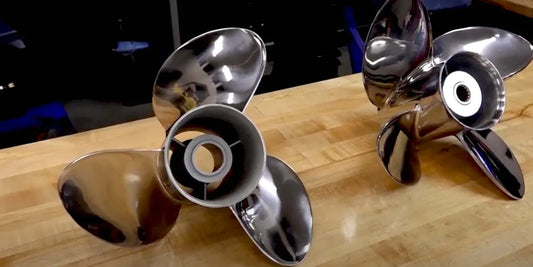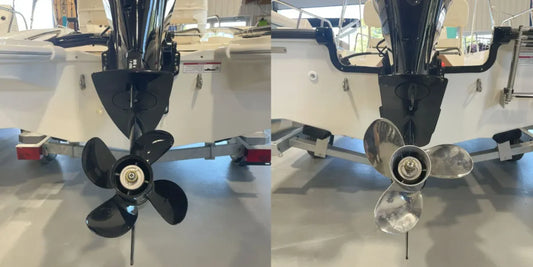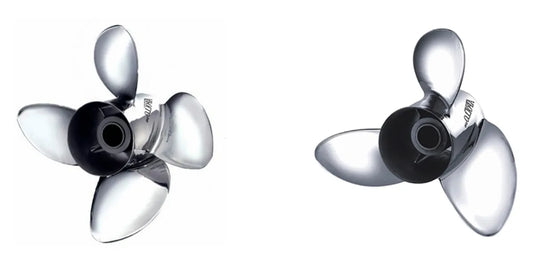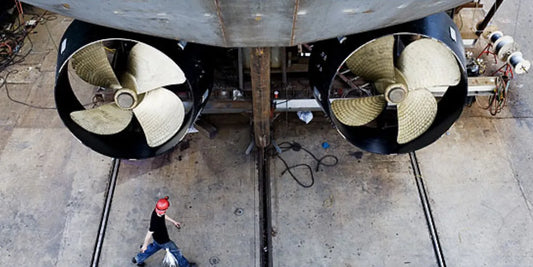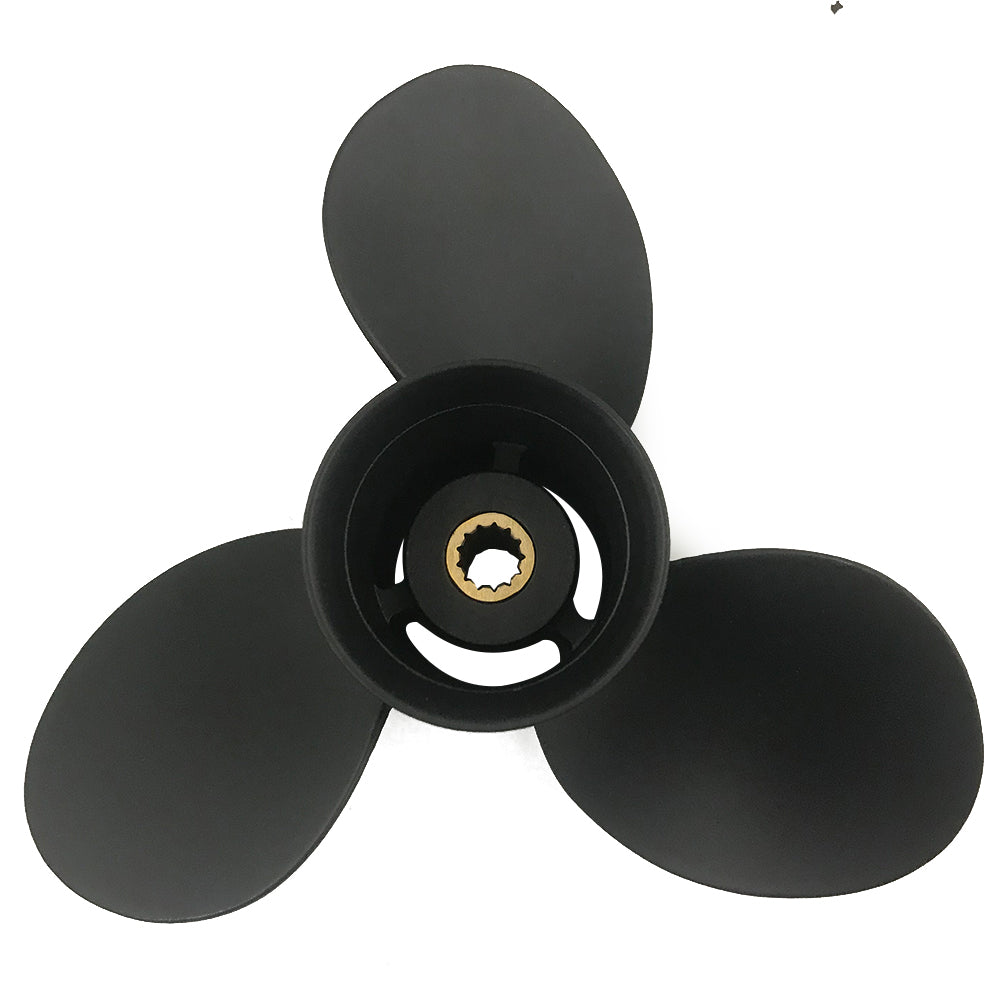Choosing the right propeller for your boat might lead to a debate between stainless steel and aluminum. Both have different benefits to offer. Which one makes the best performance for you? Whether for speed, durability, or a combination of both, your choice of propeller materials will significantly impact how your boat performs on the water. In this guide, the fundamentals of the difference between stainless steel and aluminum propellers will be explained to provide you with a clear understanding to proceed. Consider this a comprehensive comparison, encompassing all aspects of performance, cost, and durability factors that will equip your boat for optimal results.
Understanding Propeller Materials

Overview of Stainless Steel Propellers
Stainless steel propellers are among the alternatives considered for enhancing human performance, durability, and reliability. These are made from a strong and corrosion-resistant alloy that never deteriorates in a marine environment, including exposure to saline water. Being the toughest, stainless steel propellers can easily withstand significant impacts and remain slightly deformed when compared to aluminum propellers, making them suitable for long-term use in fast-moving and high-performance cruising.
Performance-wise, stainless steel propellers produce the best efficiency and precision. With their rigid set-up that allows for thin blades, they might be hydrodynamically more refined, leading to less drag and overall better fuel efficiency. Hence, they are an excellent choice for any operation seeking maximum speed or navigating waters where maximum handling is essential. From the standpoint of design capabilities, the material allows for engineered pitch and rake angles for a wider range of engine types and boating requirements.
The price of stainless steel propellers is usually higher than that of others, but their extra strength essentially means fewer maintenance expenses in the long run. For a boater needing reliability in harsh environments, the price is usually worth it. Considering your horsepower, how often you go boating, and the type of waters you use, could help you determine whether stainless steel would be best for your situation.
Advantages of Aluminum Propellers
Aluminum propellers prove to be both inexpensive and versatile for many boaters. They offer an economic price point and are, therefore, well-suited for users on a budget or casual commercial applications that do not require strength. Aluminum is lightweight, which makes its installation and handling easy, also contributing to the attractiveness of such options for recreational users. These systems can be adapted to variables from a placid freshwater lake setting to a moderate marine one.
Another considerable advantage that aluminum propellers have over stainless-steel propellers is repairability. While damages to stainless steel propellers can be hard or incur a high cost to repair, aluminum propellers tend to be easier and cheaper to repair when bent or nicked. Boaters can use this itself to manage upkeep costs over a substantial period. Furthermore, aluminum props offer an excellent trade-off between performance and protection when deployed on engines of lesser horsepower or in shallow waters filled with debris, and potential risks of serious engine damage in the event of an impact.
Generally, an aluminum propeller is best suited for value-minded, flexible users who are willing to accept easy maintenance. It delivers reliable performance for common activities while remaining affordable. The choice of propeller material is highly dependent on the type of activities one pursues and the level of performance desired; yet, aluminum propellers offer most recreational boaters an almost perfect mix of workability and affordability.
Comparison: Aluminum v/s Stainless Steel
Some primary considerations in the aluminum vs. stainless steel propeller debate include performance, durability, price, and usage cases. Aluminum propellers are more affordable and better suited for everyday, family-style boating purposes. They may be on the lighter side; they are fixable and generally cost way less than others while performing the basic job. Due to their smaller material bulk, they may be more susceptible to damage from impact or prolonged use under high loads.
When it comes to durability and performance, stainless steel propellers are the champions. Their sturdy construction allows the blades to be made thinner, which can also increase the hydrodynamic efficiency of the propeller, resulting in improved speed, acceleration, and fuel economy for the boat itself. Stainless steel propellers can handle higher horsepower and withstand harsher environments, making them ideal for performance boating and demanding conditions. However, these steels come with a stiffer price and higher repair costs compared to their aluminum counterparts.
Boat owners also need to know the kind of water in which they operate. Aluminum propellers may corrode faster than stainless steel ones in saltwater, especially if proper maintenance is not performed. Ultimately, it comes down to choosing between aluminum and stainless steel, balancing budget with performance and durability to meet their goals in the environment they work in.
Performance Factors in Boat Propellers

Speed and Acceleration with Stainless Steel
Stainless steel propellers have an established history of making high speed and acceleration a reality for those who favor speed. The rugged nature of stainless steel enables blades to maintain their shape even during deformation caused by high loads, thereby enhancing hydrodynamic efficiency. It is this efficiency that reduces drag and maximizes thrust, making it easier for boats to achieve higher speeds. Furthermore, stainless steel enables the propellers to retain much more aggressive pitch angles, generating thrust during occasions requiring rapid acceleration or carrying heavy loads. With modern stainless steel propeller designs incorporating variable blade geometry, the performance is further optimized over a broader range of operating conditions. This perfect balance between durability and performance instills confidence in any boater, and these propellers are used in both recreational and commercial applications.
Considerations about Durability for Aluminum Props
Aluminum propellers are cheap, lightweight, and are often bought by casual and recreational boaters. Usually, while good enough in durability under normal operational conditions, these props are much more prone to wear and damage compared to stainless-steel props. A thing coming into contact with a prop will result in dents or deformation, depending on the hardness of the propeller surface. Rocks, debris, or sandbars will bruise aluminum.
Through advancements in manufacturing and materials science, aluminum props have become more resilient. Many designs nowadays have reinforced alloys or coatings to impart anti-corrosive properties, thus mitigating the prolonged adverse effects of harsh environments. Such developments have extended the lifespan of aluminum propellers and made their usage more flexible under various conditions.
The aluminum ones are a cost-efficient and functional option for boaters who operate in shallower waters and areas with underwater obstacles. Frequent repairs and replacements can occur in heavy use, but the lower cost and high ease of manufacture allow for a cost-effective upgrade or replacement should the need arise. When selecting an aluminum propeller, factors such as frequency of use, local conditions, and performance requirements should be taken into account to achieve a proper balance of durability and practicality.
How the Material Affects Fuel Efficiency
Propeller materials possess fuel efficiency features that directly affect vessel performance in terms of weight, durability, and hydrodynamics. Aluminum propellers are lightweight and generally cheaper, but they are slightly flexible. This flexibility, when deformed over time under high torque or force, results in the vessel operating at less-than-optimal fuel efficiency throughout the propeller's life. Stainless steel propellers are heavier but remain very rigid, ensuring that they maintain their exact shape. This minimizes drag and maximizes power transmission, resulting in improved fuel economy, particularly at higher speeds or under heavy loads.
Numbers from various performance test cases show that a stainless steel propeller has a possible gain of 5-7% in fuel efficiency when compared with aluminum in similar operative conditions. Upon considering any increased efficiency, one must rightly assess whether the gain mentioned above will compensate, or have time to compensate, for the purchase cost of stainless steel, or whether a very lightweight application is required. Factors such as blade design, pitch, and the compatibility of propeller material with the engine also affect fuel consumption. They believe that if one can choose the right material based on actual use, the boat owner can guarantee top performance, coupled with fuel savings and longevity.
Choosing the Right Propeller for Your Boat

Identifying the Right Propeller Type
Selecting the appropriate propeller type is a critical aspect of optimizing boat performance, efficiency, and maneuverability. The actual designs of propellers vary significantly according to their intended use, engine specifications, and water conditions. One of the key factors to consider is the number of blades on the propeller. Three-blade propellers are generally used for higher-speed cruising and fuel efficiency, while a four-blade one is chosen if stability and smooth handling, or operation in rough waters, are required.
Pitch, diameter, and a few other minor considerations all matter. A high pitch gives higher-end speeds while a low pitch offers acceleration. A low-pitch prop is more suitable for pulling purposes such as water sports. A large diameter will provide more thrust, suitable for heavier boats or towing.
For commercial or fishing vessels, specialized propellers such as cupped or variable-pitch types can be employed to enhance fuel economy and improve performance across varying loads. The material also matters-most aluminum propellers are light and cheap, whereas stainless steel is more precise and durable. Consider these design decisions to reflect your specific needs onto the performance of your boat.
Factors Influencing Propeller Selection
Selecting a proper propeller requires analyzing a series of key factors that affect the performance, efficiency, and lifespan of the propeller. One of the most important factors is propeller size, typically specified by its diameter and pitch. The diameter affects it in thrust generation; pitch affects the distance traveled by the propeller in one revolution. One must strike a balance between these two to suit the power of his engine and to put no strain.
The other critical factor, Engine RPM (Revolutions Per Minute) is because the chosen propeller should allow the engine to operate at its recommended RPM range for the best fuel economy while avoiding engine damage through unnecessary wear. Operationally, blade numbers make a difference: three-blade propellers offer speed and efficiency compared to four- or more-blade counterparts, which transmit more power for smooth operation and better control in heavy seas.
Boat type and usage come next in the list of essential considerations. Higher-pitch propellers provide thrust to lightweight and fast boats, while displacement hulls often find larger diameters to be a better option. Water conditions can also play a role in consideration; for instance, a shallow or debris-laden area might warrant sturdy materials like stainless steel to ward off damage.
Lastly, think about advanced features like the ventilation system, the reduction of drag, thereby improving acceleration, and propeller cupping, better the grip against being slipped at higher speeds. Considering these factors will ensure that your propeller fits the details of the boat setup and also its application, thus giving the highest performance.
Stainless Steel or Aluminum: What Fits Your Agenda?
Knowing the performance, durability, and price of both stainless steel and aluminum marine propellers is thus crucial to analyze which fits best on your vessel. Aluminum propellers offer the benefits of being lightweight and cost-effective, making them ideal for casual boaters or those with small engines. They perform well in quieter waters and can be repaired fairly easily due to their malleability. However, their durability might be one of the casualties of rough waters or areas filled with debris, as they can bend or get damaged under high stress.
On the other hand, stainless steel propellers offer greater strength and improved performance, particularly in demanding conditions. The effects of rigid construction in minimizing flexing contribute to added efficiency, acceleration, and top-speed capabilities. The higher price of stainless steel propeller options implies that they are durable and can withstand wear and tear, making them ideal for power boats or heavy-duty applications. They might even offer greater fuel economy in the long run because of their optimized design and longevity.
This comes down to your boating needs and priorities. Aluminum might suit your needs if you consider it cost-effective and want something that can be quickly repaired for light recreational use. However, for more demanding uses, it is often better to invest in stainless steel, which offers durability, performance, and long-term value.
Maintenance and Care for Boat Propellers

Best Practices for Stainless Steel Prop Maintenance
Maintaining your stainless steel boat propellers can significantly enhance performance and prolong their lifespan. Below are some good practices for keeping your propeller in good working condition:
Regular Inspection: Check your propeller regularly for damage. Dings and minor cracks or bends can compromise the efficiency of the propeller and increase fuel consumption over time under stress. Detected earlier, such issues remain minor and less costly to repair.
Clean after using: Saltwater and debris have a way of accelerating corrosion and buildup on your stainless steel propeller. Clean your propeller with fresh water after every outing to cleanse off salt and grime that may cause damage over time.
Polishing: Periodically using a marine-grade stainless steel polish on the propeller will keep it smooth and free from corrosion. Additionally, polishing appears to be effective, as it reduces drag by maintaining a smooth and clean surface.
Grease the Propeller Shaft: Apply marine-grade grease to the shaft to prevent it from seizing and to facilitate easier removal when necessary. It should be done during routine inspections or before long-term storage.
Check for Proper Balance: An unbalanced propeller causes unnecessary vibrations that can damage your boat, particularly in relation to its engine and drivetrain. If you have a slight suspicion that there may be a problem, get the propeller checked and balanced.
Avoid Grounding and Impacts: Stainless steel remains highly resilient, but repeated impacts with submerged objects, sandbars, or rocks can cause slight rust and compromise its integrity. Try to avoid shallow waters or any areas that may have debris in them.
Consider Storage: When not in use, the propeller is best stored in a dry, covered location to protect it from moisture and atmospheric damage. If it needs to be removed, keep it in a sturdy container to prevent the prop from inadvertently incurring scratches or dents.
Professional Servicing: For in-depth cleaning, inspection, and repairs, skilled periodic maintenance can be scheduled. Consider this: Hidden issues can be identified and repaired by professionals to ensure the system operates at its best.
The aforementioned best practices will ensure that stainless steel propellers will remain efficient, durable, and reliable in marine environments.
Aluminum Propeller Care
Aluminum propellers are the first choice of many boaters simply due to their featherweight and cost-effective nature. Prolonging their lifespan and maintaining their ideal performance level is synonymous with caring for and maintaining them. Start by inspecting the propeller for nicks, cracks, or bends after every trip, as aluminum is vulnerable to damage if it collides with underwater debris. Any visible damage should be repaired immediately to prevent further deterioration and loss of propeller efficiency.
Cleaning is an equally necessary maintenance step; clean any saltwater residue, dirt, or algae with a bit of warm soapy water and a soft brush. This prevents corrosion, as aluminum is more susceptible to corrosion in marine atmospheres. After cleaning, a protective coating or wax of marine grade can be applied to provide a layer of resistance against oxidation.
Lubricating the hub with marine grease is preferable when reinstalling or removing the propeller to lessen friction and wear. Always check for any fishing lines or debris wrapped around the propeller shaft, as these will damage the seals. Also, ensure the propeller is balanced and aligned; if it is not, vibrations will occur during operation, creating strain on the engine. These simple care procedures help to keep the aluminum propellers working efficiently and resistant to wear with time.
Common Problems & Solutions for Both Materials
Both aluminum and stainless steel propellers encounter issues during operation, including environmental conditions and usage patterns. Common problems should be considered, and best practices followed to maintain and prolong their functionality properly.
Corrosion Prevention: Because both materials spend ample time in aquatic environments, corrosion is always an issue, saltwater especially. Aluminum propellers are more susceptible to electrolysis in the form of pitting, which grows larger and weaker over time. The application of paint or other protective coatings should also assist, as well as the installation of sacrificial anodes that will corrode in place of the propeller. Stainless steel is more resistant to corrosion, but can still develop crevice corrosion when water is stagnant. Thorough cleaning and inspecting the propeller for signs of major deterioration or aging will help ensure that such problems never develop in the first place.
Damage from Impact: The aluminum propellers can be dented with an impact on rocks or debris underwater, while the stainless steel ones can be bent. Although stainless steel is harder and resists bending, a big impact may still damage it. Correct navigation and regular checks before and after an outing will help limit damage caused by such impacts.
Cavitation: A rise in temperature and a drop in pressure on water can encourage the formation of cavitation bubbles surrounding the propeller. Foreseen collapse of these bubbles over a propeller erodes its blade, which results from its damage from both aluminum and stainless steel propellers, thus it is less efficient. Properly sizing, aligning, and pitching the propeller to the engine and boat, while maintaining a smooth blade surface, best ensures minimal erosion from cavitation.
Vibration and Noise: An uneven or defective propeller, be it of aluminum or stainless steel, would produce excessive vibration or noise during operation. Such undesirable phenomena affect the propeller's performance and add strain to the engine. Keeping the propeller well-balanced, carrying out regular checks for chips or bends, and adjusting any misalignment would go a long way in reducing such annoyances.
Performance Degradation: The wear will continue, causing performance degradation, whether it is an aluminum or stainless steel propeller. Aluminum propellers lose their coating while stainless steel blades get small dings and scratches. Maintenance periodically, which includes repainting aluminum blades and polishing stainless steel, would restore it to its optimal operating level.
These problems should be treated preventively and promptly; if left unaddressed, they can escalate into extremely costly repairs. Proper prevention extends the life of an aluminum and stainless steel prop, while preventing these problems is the one thing that results in the propeller remaining trusty and consistent in performance for the boater.
Cost Considerations: Investing in Your Propeller

Price Comparison of Stainless Steel and Aluminum Props
Pricewise, aluminum propellers have generally proven to be lower-priced than their stainless steel counterparts. Aluminum props tend to be/bare inexpensive and are a reasonable choice for casual or recreational boaters whose equipment does not undergo rough treatment. Aluminum weighs less but is also easier to fabricate, allowing this to be reflected in the price. This, then, is chosen particularly by someone seeking a practical and economical solution without incurring a significant upfront cost.
While the stainless steel propellers tend to come with a higher price, their cost is often justified by the long-term value they offer. Greater durability and slight adjustments make them better suited for high-performance jobs where resistance to bending, warping, or other damage is paramount. I have found that these props provide better efficiency and acceleration just because of their slight elevation in design precision. In any case, if a boater is looking for something that performs well in both performance and resistance, especially in rough waters or for frequent use, stainless steel is a worthy investment.
Ultimately, the decision depends on individual preferences, boating styles, and budgets. Aluminum jets should provide reliable performance, with occasional boating seen in fairly calm waters, without incurring much cost. Meanwhile, steel jets have their advantages in durability, gaining better performance and greater savings in the long run; thus, they are worth the initial higher cost.
Read More: Long-term Value of Steel and Aluminum
In my experience, the long-term value generally far outweighs that of aluminum in most circumstances. While stainless steel propellers will, in any case, cost more to install, considering their durability and efficiency, the cost may be worth it, provided it is spread over time. Stainless steel is far more resistant to wear and damage so that it can endure rougher treatments without frequent assembly. For my part, the long life and ruggedness of the stainless steel propeller clinch the case for me-I want something that will last and minimize my maintenance.
Here are some examples of aluminum propellers: these are less expensive and may be preferable if you are mainly navigating in calm waters at lower speeds. In contrast, they bend easily and corrode, resulting in deterioration over a short period; hence, replacement costs can accumulate. Upon considering repair and replacement costs, it becomes evident that stainless steel is the more cost-effective solution in the long run.
Ultimately, it is an individual choice, based on one's specific needs and preferences while boating. Look at aluminum if you want to save money upfront and only boat sporadically under easy conditions. On the other hand, if you boat in the middle of everything or would like to keep your equipment around for longer, then this stainless steel tackle is worth every penny, in our opinion.
Reference Sources
-
Aluminum vs Stainless Steel Prop Blog - Michigan Wheel
Discusses performance, handling, and the advantages of stainless steel in 3-blade props. -
Prop Bites: How To Choose Between Aluminum and Stainless Steel Props - Mercury Marine
Highlights the superior performance and durability of stainless steel over aluminum. -
Aluminum vs. Stainless Steel Props: What's the Difference? - Boats.net
Explores rigidity, durability, and suitability for high-horsepower motors. -
Is an Aluminum or Stainless Steel Propeller Right For You? - Boat Specialists
Provides guidance on choosing the right prop based on engine horsepower. -
Stainless Steel vs Aluminum Prop: What's The Difference? - Deep Blue Yacht Supply
Discusses durability, reduced drag, and design options for stainless steel props.
Frequently Asked Questions (FAQs)
What is the real difference between stainless steel and aluminum boat props?
Conversely, in terms of strength, performance, and material properties, there are notable differences between stainless steel and aluminum-manufactured propellers. A steel prop is valued for its strength and the good performance it provides, especially at high speeds, whereas aluminum propellers are lighter and more affordable. Stainless steel can resist damage caused by impact, making it a favorable choice for those who usually operate their boats in shallow waters or sandy conditions, where it can withstand significant hits. Aluminum propellers offer more straightforward repairs and can be a very affordable choice for small or low-hp boats. Ultimately, it will be determined by your boating requirements and budget.
Why do I want a stainless steel propeller on my boat?
For improved acceleration and higher top speed, consider selecting a stainless steel propeller. Stainless steel props come at a higher cost compared to their aluminum counterparts, but essentially, they are worth every cent for the serious performance boater. Having thicker blades than aluminum, stainless steel props create a better grip, especially when the plane is cruising at high speeds. A stainless steel prop is also much more resistant to bending or deformation when striking an object, saving you from a lot of repairs. So, if you spend most of your time in rough environments, then the stainless steel prop is the ideal propeller for your boat.
Are aluminum and stainless steel props interchangeable?
Aluminum or stainless steel props serve the same purpose, but they are not always interchangeable. The prop shaft and lower unit must be designed to withstand the torque and power transmitted by the chosen material. Additionally, the diameter and pitch of the props should match the boat's specifications for optimal performance. Using the wrong kind of prop results in poor fuel economy and inefficient use. It would be wise to consult a prop shop or a local expert if you plan to switch between aluminum and stainless steel props.
How do I maintain my stainless steel prop?
The care of a stainless steel prop requires almost constant inspection and cleaning to prevent corrosion and the buildup of marine growth. Compared to aluminum props, stainless steel ones require repairs very seldom; however, they should be inspected for any scratches or dings that may compromise their performance. If any damage is observed, it is best to have it repaired at a prop shop. Always make sure that the prop is well lubricated and that there is no wear on the prop shaft. Regular maintenance will surely extend the lifespan of the stainless steel prop and ensure smooth operations of the boat.
Can I use a 4-blade aluminum prop on a higher horsepower engine?
Four blades of aluminum could lift the higher-horsepower engine better for acceleration and performance. This, of course, depends on the design of the particular propeller and the intended use of your boat. Aluminum props are generally softer than stainless steel; however, a good aluminum prop will hold up quite well. If you want to run at higher speeds on a rough water surface, then upgrading to a stainless steel prop would be ideal for you, as steel is tough and will provide greater efficiency. In all cases, make sure the prop matches the boat's specifications. If not, performance will suffer.
What should I consider when choosing a new prop for my boat?
A range of factors should be considered when selecting a new propeller for a boat, including the material (aluminum or stainless steel), the number of blades (3-blade or 4-blade), and the diameter and pitch. Without a doubt, a right, fitting propeller will influence acceleration, maximum speed, and fuel economy of your boat. Consider, when setting your prop, the weather and operating conditions under which you primarily operate: are you mostly in shallow water, or do you mainly operate in rough seas? Moreover, consulting a local expert in props will benefit you in identifying which prop options best fit your needs.


